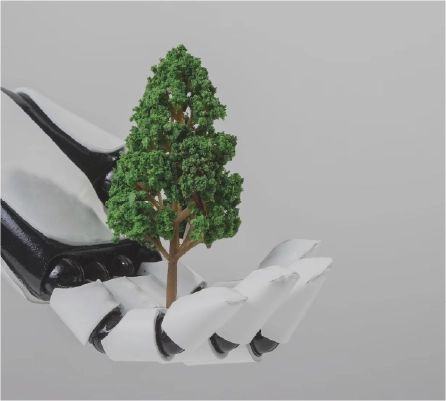Project Management
AI – The guide towards Sustainable Climate
- Surya Vamsi
- June 11, 2021

The UNESCO, the UN Environment Programme, Microsoft and StartUp inside, which works with Fortune 500 companies in digital transformation held the virtual ‘AI for the Planet’ conference in February to discuss the rising dangers and the intensifying need to battle climate change. Scientific assessments from the UN stated that humans utmost have a period of 10 years to solve these unprecedented global environmental challenges. These not only include climate change, but also biodiversity loss, ocean protection, pollution management, air, and water quality.
Global researchers and scientists believe that Artificial Intelligence and Big Data can be the major contributors in battling these climate changes and environmental hazards. With the help of AI, the problem-solving approach can be quicker, more efficient, and more productive.

AI will be the core facilitator of these efforts pushing the world towards more stable and controlled climatic conditions. AI and machine learning can be used to adopt more sustainable practices and better consumption choices. The deeper we engage AI in analyzing the present and predicting the future, the better are our chances at creating a better future with sustainable and green sources of energy. Here are the few ways AI can help battle climate change-
Better Climate Predictions-
A previously built consortium called climate informatics utilizes both data collections and climate sciences to predict extreme climatic changes preceeding hurricanes, climate downscaling, integrating models to predict real-time local climate and the socio-economic impacts of climate change.
AI can be employed by similar consortiums to analyze the mass data available and unlock new interpretations in a snap of a finger, unlike manual analysis and interpretation which takes monstrous amounts of time to execute. AI also enables real-time modification of the data depending upon the instantaneous changes in the variables caused due to unpredictable climatic factors. These predictions can help the officers make informed decisions while drafting the climate policies, enable governments to prepare for changes and also possibly uncover a few important aspects that can reverse the climatic change.
Reducing Wildlife risk due to unforeseen imperfections-
Major states like California are employing drones fitted with computerized camera visions to continuously monitor the vast and huge equipment for any faults. This comes in along with their efforts to reduce the possibility of wildfires due to equipment faults. Apart from destroying wildlife, wildfires are also one of the major sources of carbon emissions which in itself contribute to the greenhouse effect and global warming. Utilizing AI to this extent would help major organizations rectify the existing faults at any part of the transmission chain.
Quicker Responses to Climate change-
As per the UN, there has been a Global loss of around USD3 trillion from the year 2000-2019 due to climate changes. The atmospheric CO2 levels at present are highest compared to any point in human existence, with average temperatures continuously rising since the last decades, sea level rising above 8 inches, 2019 recording the highest ocean temperatures ever. With these many factors going well out of our control, we must employ better means and responses to the changing environment and climate factors to ensure safer existence. Greenhouse gases released by every economical sector are constantly rising contributing to global warming.

According to Capgemini Research Institute, AI will assist organizations from various industries from retail to automotive achieve around 45% of the targets set up in the Paris Agreement by the year 2030. It also researched that AI has reduced the emission of Greenhouse Gases by 14% and will likely reduce them to 16% in the near future. These improvements speak for themselves showcasing how AI can quickly design sustainable models to reduce the overall impact on the climate thereby reducing the drastic effects.
Discovery of new materials-
With the increasing dependency on non-renewable resources of energy, it is almost imperative to discover new materials that can help withstand the stress on these resources or serve as another source. AI can help scientists accelerate this by finding, designing and also evaluating new chemical structures of the complex compounds that can serve similar purposes. These materials could one day, for example, increase the efficiency of the solar panels, replace steel and other chemicals thereby help to reduce the overall carbon emissions from the industries.
The production of cement and steel accounts for around 10% of the global greenhouse gas emissions. AI, if able to discover new materials with a lower carbon footprint but similar properties can help reduce the overall emissions from the manufacturing of these materials.
Environmental Intelligence
With massive weather changes taking place resulting in massive destruction and migrations, AI can help make better predictions about the changes with improved accuracy of around 90%. By analyzing complex data in shot spans using linear regression principles, meteorologists are employing AI to save both time and money. Google’s AI forecast tool, for example, is based on UNET conventional Neural Network which refers to sequentially arranged mathematical operations that allow the transformation of the inputs from satellites into image outputs. Apart from this, the weather forecasting possibilities of AI are multifold. With more advanced research and upgrades, AI has the potential to also map out the radial imagery of the weather events like cyclones, high precipitation centers, etc to stay prepared even before the incident occurs.
Precision Agriculture
Most of the agricultural practices followed nowadays are monocultures, which refer to the cultivation of one single kind of crop in the land. This makes it easier for the farmers to manage the land and more economical in terms of expenses. However, the downside of this practice is that it strips the soil of its valuable nutrients. To compensate for this loss, farmers often use nitrogen-based chemicals and fertilizer which again contribute to pollution and greenhouse emissions. AI can make a calculated scheme to allow the farmers a proper mix of crops to support better soil health at an economical and convenient price.
AI’s Carbon Footprint
Although AI has the potential to rescue worldwide carbon emissions by a considerably huge margin, data centers and AI giants are also exploiting fossil fuels and other limited resources to stay on their feet.
The University of Massachusetts at Amherst has recently released a report that estimated that the power and electricity required for searching and training a certain neural network architecture releases around 626,000 pounds of carbon dioxide. This is approximately 5000 times the lifetime emissions of a car.
Considering this, researchers are making efforts to reduce the overall carbon footprint of AI. For this purpose, they developed a once-for-all-network that trains one mega neural network which contains several smaller neural networks which can be modified to specific hardware without any retention. As a result, the amount of energy required reduces by a considerable amount hence reducing the overall carbon emissions.
Taking into account both the advantages and disadvantages of AI, the only possible way to ensure a constructive output from its services is by managing and utilizing AI most efficiently and economically wherein the advantages outweigh the drawbacks.
